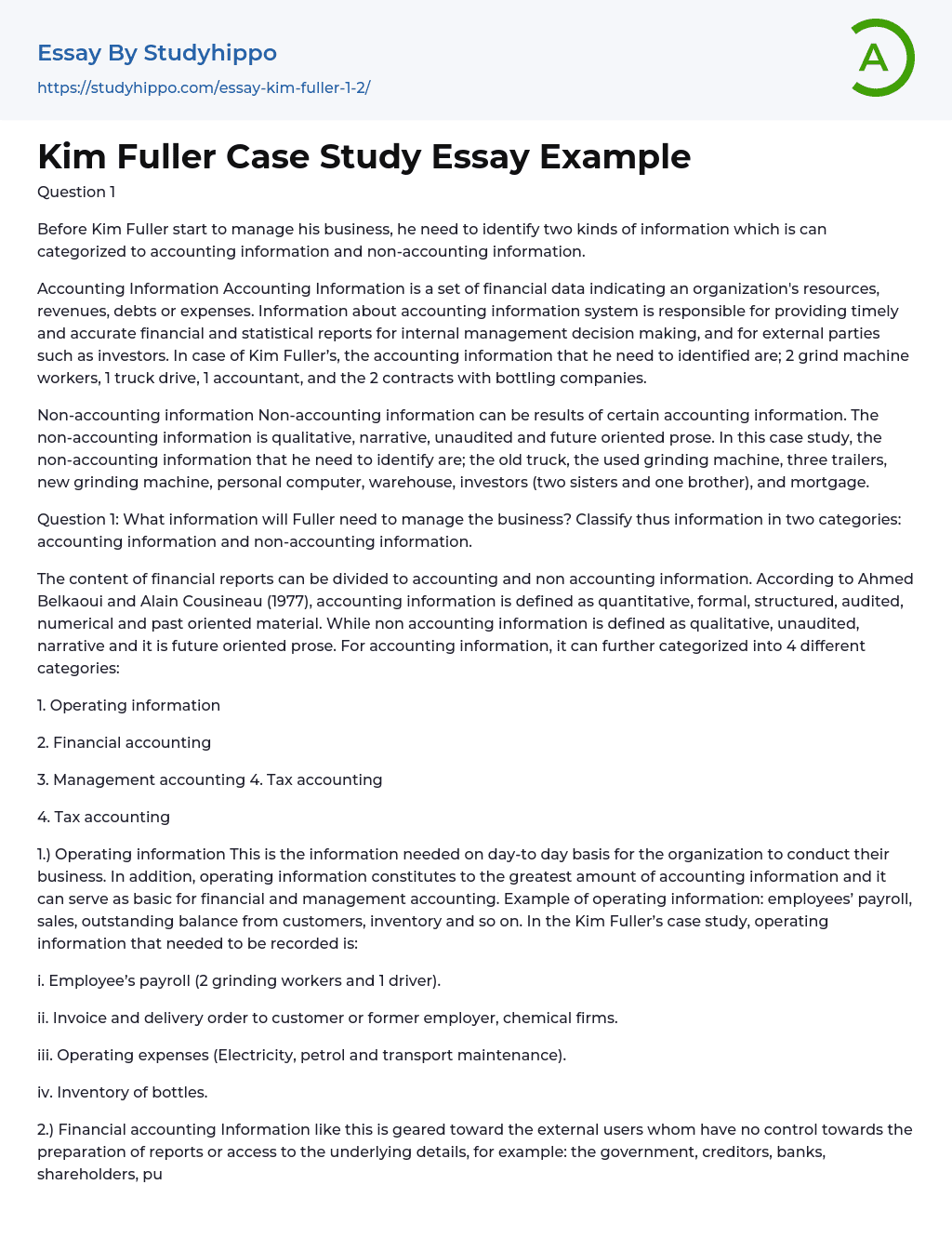Before Kim Fuller start to manage his business, he need to identify two kinds of information which is can categorized to accounting information and non-accounting information.
Accounting Information Accounting Information is a set of financial data indicating an organization's resources, revenues, debts or expenses. Information about accounting information system is responsible for providing timely and accurate financial and statistical reports for internal management decision making, and for external parties such as investors. In case of Kim Fuller’s, the accounting information that he need to identified are; 2 grind machine workers, 1 truck drive, 1 accountant, and the 2 contracts with bottling companies.
Non-accounting information Non-accounting information can be results of certain accounting information. The non-accounting information is qualitative, narrative, unaudited and future oriented prose. In this case study, the non-accounting information that he need to identify are; the old truck, the used grinding machine, three trailers,
...new grinding machine, personal computer, warehouse, investors (two sisters and one brother), and mortgage.
Question 1: What information will Fuller need to manage the business? Classify thus information in two categories: accounting information and non-accounting information.
The content of financial reports can be divided to accounting and non accounting information. According to Ahmed Belkaoui and Alain Cousineau (1977), accounting information is defined as quantitative, formal, structured, audited, numerical and past oriented material. While non accounting information is defined as qualitative, unaudited, narrative and it is future oriented prose. For accounting information, it can further categorized into 4 different categories:
1. Operating information
2. Financial accounting
3. Management accounting 4. Tax accounting
4. Tax accounting
1) Operating information
View entire sample
justify;">This is the information needed on day-to day basis for the organization to conduct their business. In addition, operating information constitutes to the greatest amount of accounting information and it can serve as basic for financial and management accounting. Example of operating information: employees’ payroll, sales, outstanding balance from customers, inventory and so on. In the Kim Fuller’s case study, operating information that needed to be recorded is:
i. Employee’s payroll (2 grinding workers and 1 driver).
ii. Invoice and delivery order to customer or former employer, chemical firms.
iii. Operating expenses (Electricity, petrol and transport maintenance).
iv. Inventory of bottles.
2) Financial accounting
Information like this is geared toward the external users whom have no control towards the preparation of reports or access to the underlying details, for example: the government, creditors, banks, shareholders, public and etc. To ensure uniformity, the information reported is subjected to a set of ground rules and prepared under generally accepted accounting principles (GAAP). As for the case study, the information needs to be recorded under financial accounting.
- Accounts Receivable essays
- Auditor's Report essays
- Balance Sheet essays
- Costs essays
- Financial Audit essays
- International Financial Reporting Standards essays
- Tax essays
- Accountability essays
- Cash essays
- Principal essays
- Management Accounting essays
- Internal Control essays
- Accounting Software essays
- Cash Flow essays
- Net Present Value essays
- Income Statement essays
- Accounting essays
- Andrew Carnegie essays
- Automation essays
- Business Cycle essays
- Business Intelligence essays
- Business Model essays
- Business Operations essays
- Business Software essays
- Cooperation essays
- Cooperative essays
- Corporate Social Responsibility essays
- Corporation essays
- Customer Relationship Management essays
- Family Business essays
- Franchising essays
- Harvard Business School essays
- Harvard university essays
- Human Resource Management essays
- Infrastructure essays
- Inventory essays
- Logistics essays
- Management essays
- Manufacturing essays
- Market essays
- Marketing essays
- Multinational Corporation essays
- News Media essays
- Online Shopping essays
- Quality Assurance essays
- Richard Branson essays
- Sales essays
- Selling essays
- Shopping Mall essays
- Small Business essays




